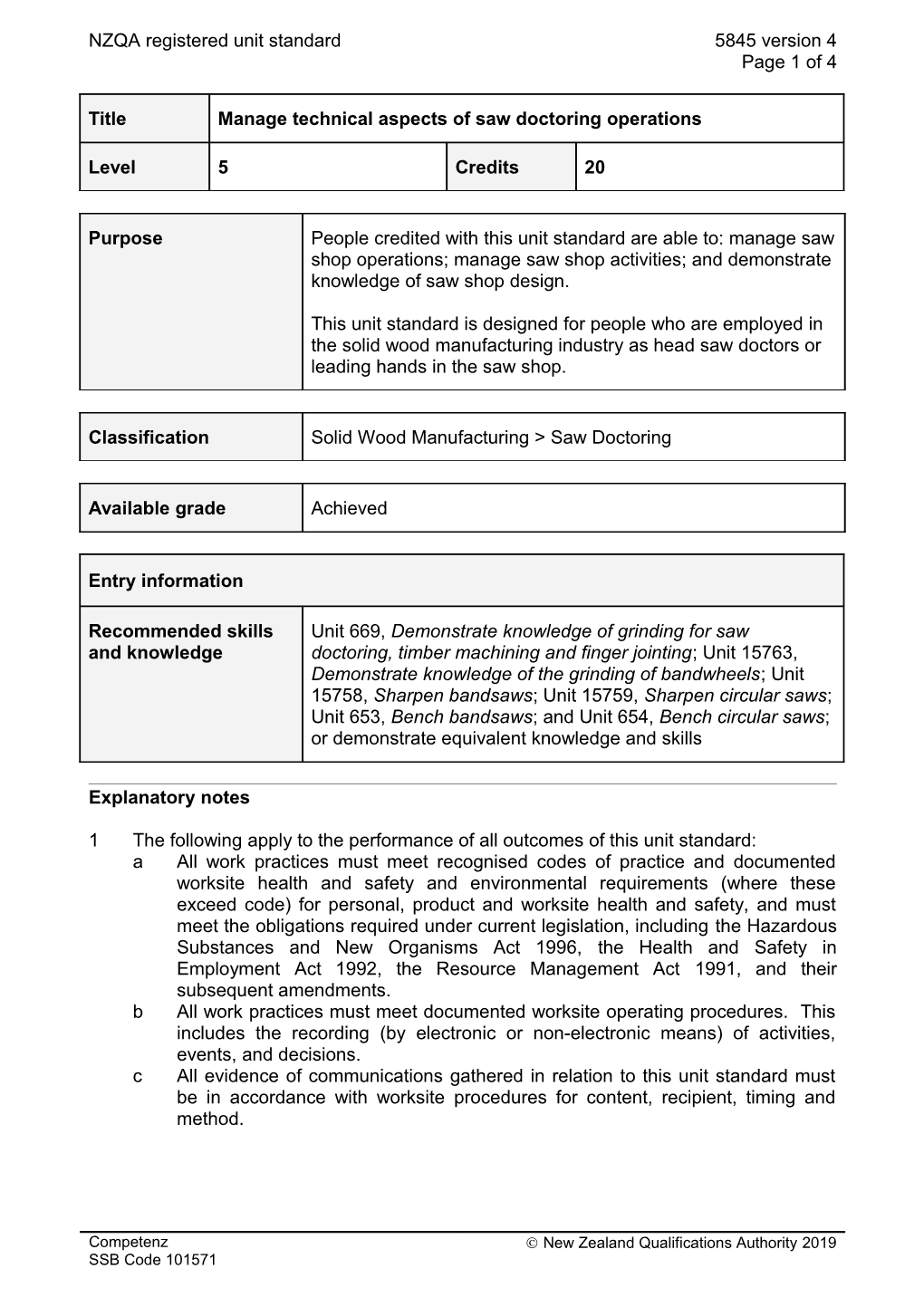Page 1 of 4
Title / Manage technical aspects of saw doctoring operations
Level / 5 / Credits / 20
Purpose / People credited with this unit standard are able to: manage saw shop operations; manage saw shop activities; and demonstrate knowledge of saw shop design.
This unit standard is designed for people who are employed in the solid wood manufacturing industry as head saw doctors or leading hands in the saw shop.
Classification / Solid Wood Manufacturing > Saw Doctoring
Available grade / Achieved
Entry information
Recommended skills and knowledge / Unit 669, Demonstrate knowledge of grinding for saw doctoring, timber machining and finger jointing; Unit 15763, Demonstrate knowledge of the grinding of bandwheels; Unit 15758, Sharpen bandsaws; Unit 15759, Sharpen circular saws; Unit 653, Bench bandsaws; and Unit 654, Bench circular saws; or demonstrate equivalent knowledge and skills
Explanatory notes
1The following apply to the performance of all outcomes of this unit standard:
aAll work practices must meet recognised codes of practice and documented worksite health and safety and environmental requirements (where these exceed code) for personal, product and worksite health and safety, and must meet the obligations required under current legislation, including the Hazardous Substances and New Organisms Act 1996,the Health and Safety in Employment Act 1992, the Resource Management Act 1991, and their subsequent amendments.
bAll work practices must meet documented worksite operating procedures. This includes the recording (by electronic or non-electronic means) of activities, events, and decisions.
cAll evidence of communications gathered in relation to this unit standard must be in accordance with worksite procedures for content, recipient, timing and method.
2Definitions
Optimise refers to improving productivity and product quality.
Worksite policies and procedures refer to documented policies and to documented or other directions provided to staff. These include, but are not limited to, ways of managing health and safety, environmental considerations, quality, and production, and must conform to legislation. Examples include standard operating procedures, company health and safety plans, on-site briefings, and supervisor’s instructions.
Outcomes and evidence requirements
Outcome 1
Manage saw shop operations.
Evidence requirements
1.1Staff are strategically placed to optimise saw shop outputs and maintain safety standards.
Rangeincludes but is not limited to – staff capability/versatility, individual placements, team composition, supervisory requirements.
1.2Work responsibilities, authorities, and accountability are allocated and coordinated within the work shop in accordance with worksite policies and procedures.
Rangeincludes but is not limited to – job descriptions, job cards, standard operating procedures, production schedules/timetables, reporting lines, log books, records and reports, special instructions.
1.3Stock inventory levels and movements are coordinated to optimise cost effectiveness and minimise disruption to saw mill production.
1.4Saw shop maintenance activities are planned to meet equipment and production needs.
1.5Housekeeping activities are organised to meet legislative requirements and worksite policies and procedures.
1.6Back-up resources are available to meet contingencies in accordance with worksite policies and procedures.
Rangepersonnel, operating materials, equipment.
1.7Communication with management, operational staff, suppliers, and support personnel is managed to contribute to optimising performance and maintaining efficiency of saw shop operations.
Outcome 2
Manage saw shop activities.
Evidence requirements
2.1Communication and information flows are maintained in accordance with worksite policies and procedures.
2.2Staff and saw shop performance is monitored for productivity and output quality against worksite policies and procedures and customer requirements.
2.3Saw shop activities conform with legislative requirements and worksite environmental requirements.
2.4Safety, health and housekeeping standards are maintained at all workstations in accordance with worksite policies and procedures.
2.5Maintenance schedules meet equipment and production needs in accordance with worksite policies and procedures.
2.6Variable costs are monitored and controlled against budget in accordance with worksite policies and procedures.
Outcome 3
Demonstrate knowledge of saw shop design.
Evidence requirements
3.1Saw shop design is explained in terms of factors that impact on layout.
Rangefactors may include but are not limited to – ventilation, storage, lighting, safety, access, office space, extraction, relationship to sawmill, relationship to transport, first aid, hot work, fire control.
3.2Saw shop design is explained in terms of conformance with worksite policies and procedures and legislative requirements.
Rangehealth and safety legislation, environmental legislation, hazardous materials, workplace emergency requirements.
Planned review date / 31 December 2016Status information and last date for assessment for superseded versions
Process / Version / Date / Last Date for AssessmentRegistration / 1 / 24 October 1996 / 31 December 2012
Review / 2 / 10 February 1999 / 31 December 2012
Review / 3 / 18 December 2006 / 31 December 2013
Review / 4 / 21 June 2012 / N/A
Consent and Moderation Requirements (CMR) reference / 0173
This CMR can be accessed at http://www.nzqa.govt.nz/framework/search/index.do.
Please note
Providers must be granted consent to assess against standards (accredited) by NZQA, before they can report credits from assessment against unit standards or deliver courses of study leading to that assessment.
Industry Training Organisations must be granted consent to assess against standards by NZQA before they can register credits from assessment against unit standards.
Providers and Industry Training Organisations, which have been granted consent and which are assessing against unit standards must engage with the moderation system that applies to those standards.
Requirements for consent to assess and an outline of the moderation system that applies to this standard are outlined in the Consent and Moderation Requirements (CMR). The CMR also includes useful information about special requirements for organisations wishing to develop education and training programmes, such as minimum qualifications for tutors and assessors, and special resource requirements.
Comments on this unit standard
Please contact the Competenz at if you wish to suggest changes to the content of this unit standard.
CompetenzSSB Code 101571 / New Zealand Qualifications Authority 2019
